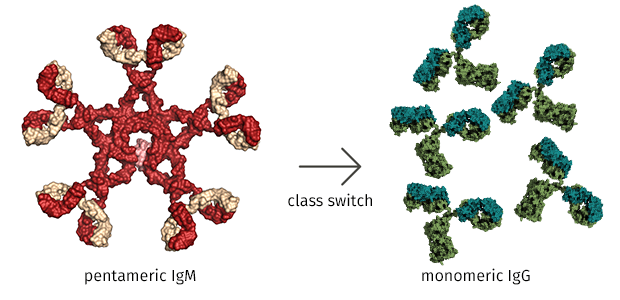LJI investigators reveal that TET proteins regulate factors essential for normal antibody production
Apr 26, 2019 // Science Immunology
New study sheds light on what goes awry in malignancies marked by TET mutation
LA JOLLA, CA—A family of TET proteins regulates gene expression in many cell types by influencing chromosome structure. TET proteins are particularly critical for proper immune cell function, as mice and humans harboring TET mutations develop B cell malignancies. The molecular basis for these cancerous changes had until now remained unclear, because researchers did not understand the normal function of TET proteins in healthy B cells.
The team of La Jolla Institute for Immunology investigator Anjana Rao, Ph.D., addresses that question in the April 26, 2019, issue of the journal Science Immunology. They report that genetic deletion, or mutation, of TET2 and TET3 in mouse B cells damps down the generation of functional IgG antibodies, decreasing the effectiveness of immune responses.
Moreover, they identify a B cell gene that becomes aberrantly silenced in the absence of TET2 and TET3, highlighting how critical “epigenetic” control of gene expression is for healthy immune cell function and hinting at why TET loss promotes oncogenesis.
DNA can be loosely or tightly coiled—tight coiling silences genes buried within chromosomal twists, while gene expression proceeds as coils unwind and DNA becomes more accessible. This process is influenced by TET proteins, which modify the chemical structure of DNA by altering a methyl group attached to C, one of the four DNA bases A, C, T and G. This so-called “epigenetic regulation” by altering DNA accessibility or structure is a major strategy that cells use to switch genes on and off.
“Previously people knew that TET proteins were involved in suppressing cancer,” says study-co-author Chan-Wang Jerry Lio, Ph.D., one of the study’s two co-first authors. “But it was difficult to tease out what the normal function of TET genes was because mice developed cancer so rapidly when we deleted them.”
The new study circumvents this issue by using an alternate “conditional knock-out” strategy in which experimenters deleted TET2 and TET3 in mature B cells at a time point of their choice in experimental mice. Five days later, they removed the mouse’s B cells and performed a battery of molecular tests to compare their activity with B cells derived from normal mice in which TET2 and TET3 remained intact.

A critical difference was that when stimulated by an experimental pathogen, mutant B cells that lacked TET2 and TET3 produced an overabundance of a class of antibody called IgM, whereas normal control B cells churned out more effective antibodies classified as IgG or “gamma globulin”.
“Antibodies come in different ‘flavors’”, explains Vipul Shukla, Ph.D., the study’s other co-first author. “The standard flavor (IgM) does a poor job of activating other immune cells. So once a normal B cell encounters a pathogen, it tries to convert IgM antibodies to a more beneficial flavor to mount an effective immune response.”
That “beneficial” flavor, known to immunologists as IgG, constitutes ~75% of all antibodies found in normal human serum and is what you received if you ever got an immunity-boosting gamma globulin shot.
Healthy B cells have no problem converting IgM to IgG using an innate gene editing trick called “class switching”, in which protein tools snip out IgM-specific regions in a DNA strand and then paste in analogous IgG DNA sequences. That maneuver creates recombined genes that express IgG antibodies, which unlike IgM, are capable of neutralizing pathogens, helping other cells recognize invaders (including cancer cells), and maintaining an organism’s well-being.
And that is where TET comes in. Rao’s group found that mutant B cells lacking TET2 and TET3 flip this switch poorly and instead remain stuck making IgM antibodies because they lack the requisite DNA splicing tool. Specifically, mutant cells lacking TET2 and TET3 do not make enough of a protein called AID, which actually executes the IgM-to-IgG splicing trick, simply because TET2 and TET3 were not available to demethylate and hence enhance expression of the AID gene. In mutant cells lacking TET2 and TET3, the AID gene likely remains methylated, inaccessible and silent, allowing IgM antibodies to predominate.
An inability to perform class switching has clinical consequences: patients who inherit mutations in the AID gene (which in humans is called AICDA) suffer an immune deficiency called hyper IgM syndrome, in which their B cells can’t make the normal conversion of IgM to IgG antibodies. Those individuals are more vulnerable to severe infection and to malignancy.
TET genes have not yet been implicated in hyper IgM syndrome. But the revelation that the AID gene is a TET target makes unquestionable immunological sense to Lio in this context. “TET2 is the most frequently mutated gene in blood cancers including diffuse large B cell lymphomas, which suggests that it restrains cancer progression in normal B cells” he says. “More importantly, the full activity of TET proteins requires vitamin C. Our study may explain how a healthy diet may enhances the immune response.”
Shukla concurs. “TET proteins are often inhibited in cancers, including cancers derived from B cells addressed here,” he says. “An important rationale for this paper was to identify the normal function of TET proteins so that we better understand why cancers develop when TET genes are restrained.”
The study was funded by a Cancer Research Institute Irvington Postdoctoral Fellowship, the Independent Investigator Fund (LJI), and a Leukemia and Lymphoma Society Postdoctoral Fellowship. It was also supported by the National Institutes of Health (NIH) grants R35 CA210043, R01 AI109842 and AI128589 (to A.R.) and R01 AI127642 (to D.G.S.). Additional support came from Institute Leadership Funds from the LJI and by NIH Grants R01 MH111267, R35 GM128938, S10OD016262 and S10RR027366.
Chan-Wang J. Lio, Vipul Shukla, Daniela Samaniego-Castruita, Edahi González-Avalos, Abhijit Chakraborty, Xiaojing Yue, David G. Schatz, Ferhat Ay, Anjana Rao. TET enzymes augment AID expression via 5hmC modifications 1 at the Aicda superenhancer. Science Immunology, 2019.